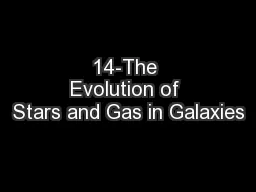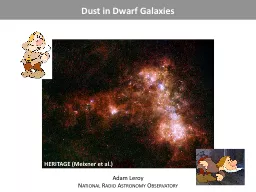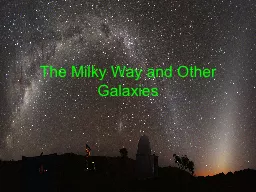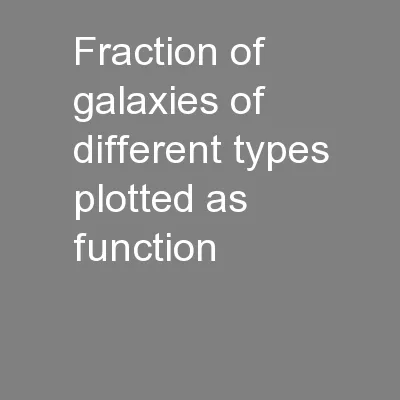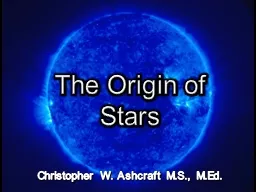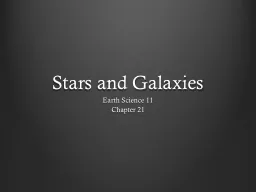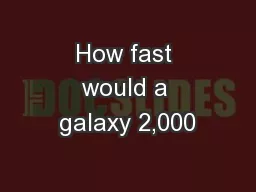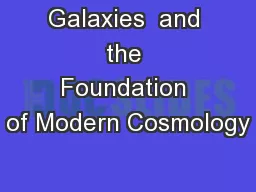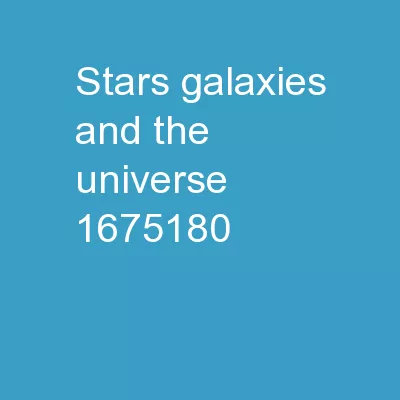PPT-14-The Evolution of Stars and Gas in Galaxies
Author : jane-oiler | Published Date : 2017-05-01
Elliptical Galaxies Spiral Galaxies Barred Spiral Lenticular Irregular L arge M agellanic C loud Dwarf Spheroidal Galaxy Isochrone 25x10 8 yrs Isochrone 4x10
Presentation Embed Code
Download Presentation
Download Presentation The PPT/PDF document "14-The Evolution of Stars and Gas in Gal..." is the property of its rightful owner. Permission is granted to download and print the materials on this website for personal, non-commercial use only, and to display it on your personal computer provided you do not modify the materials and that you retain all copyright notices contained in the materials. By downloading content from our website, you accept the terms of this agreement.
14-The Evolution of Stars and Gas in Galaxies: Transcript
Elliptical Galaxies Spiral Galaxies Barred Spiral Lenticular Irregular L arge M agellanic C loud Dwarf Spheroidal Galaxy Isochrone 25x10 8 yrs Isochrone 4x10 9 yrs IMF in the ρ Oph Association. The Cosmic Time Machine. Astronomical telescopes can’t help viewing the past.. . Distance and time are always mixed in astronomical observations.. The finite speed of light means that we always see things after they have happened–a delay of 8 minutes for the Sun and about 12 billion years for the most distant galaxies we can observe. In other words,. Adam Leroy. National Radio Astronomy Observatory. HERITAGE (. Meixner. et al.). Dust in Dwarf Galaxies. Adam Leroy. National Radio Astronomy Observatory. HERITAGE (. Meixner. et al.). SAGE (. Meixner. Recap. Canvas homework: due on Wednesday. Lab this week: Galaxy Morphology. Campus Observatory. Milky Way galaxy. Stars: . brightnesses. , masses, sizes, compositions, evolution. Interstellar matter: gas, dust. Galaxy Morphology and Environment. Main relation – . E’s more common in clusters than field. f(E. ) = fraction of ellipticals . f(Sp. ) = fraction of spirals. regular, symmetric cluster – . f(E. Christopher W. Ashcraft M.S., M.Ed.. Big Bang vs. Creation. Origin of Stars. Solar System: Evidence of Design. Age of the Cosmos. Are we being told all the evidence or just selected information to support a particular idea?. 23. vs. .. 1. First spiral nebula found in 1845 by the Earl of . Rosse. . Speculated it was beyond our Galaxy.. 1920 - "Great Debate" between Shapley and Curtis on whether spiral nebulae were galaxies beyond our own. Settled in 1924 when Edwin . Earth Science 11. Chapter 21. Constellations. Constellation:. A groups of stars that appear to form patterns in the sky.. 88 different constellations can be seen from the Northern and Southern hemispheres.. . Loners. Interactions were once . believed to be unimportant . and rare.. Galaxies were thought to . be . isolated loners. , well . separated from one . another . a. nd scarcely interacting.. Au Contraire!. megaparsecs. away be moving with respect to us, according to Hubble’s Law? Hint: H. 0. = 70 km/s/. Mpc. 1,400 km/s. 14,000 km/s. 140,000 km/s. 140 km/s. How fast would a galaxy 2,000 . megaparsecs. Let’s look back at the rotational velocity equation:. v = (M. interior. G/r). 0.5. The rotational velocity is constant at big r values.. What must we conclude?. The mass interior to the orbit is still increasing. Even after the radius r has gone beyond the last of the stars. It must be increasing in order to hold v constant.. Islands of Stars. Our goals for learning. :. How are the lives of galaxies connected with the history of the universe?. What are the three major types of galaxies?. How are galaxies grouped together?. .. 1. First spiral nebula found in 1845 by the Earl of . Rosse. . Speculated it was beyond our Galaxy.. 1920 - "Great Debate" between Shapley and Curtis on whether spiral nebulae were galaxies beyond our own. Settled in 1924 when Edwin . Chapter 21. How does distance affect an image?. Telescope- device that makes an object in the sky appear closer.. Revolutionized astronomy (study of space)- allowed them to see objects in space for first time.. Laura . Magrini. INAF- . Osservatorio. . Astrofisico. di . Arcetri. In Our Galaxy. Open clusters (disc population): . Many (~2200 known clusters). . even more new candidates in the inner disc from infrared surveys .
Download Document
Here is the link to download the presentation.
"14-The Evolution of Stars and Gas in Galaxies"The content belongs to its owner. You may download and print it for personal use, without modification, and keep all copyright notices. By downloading, you agree to these terms.
Related Documents

